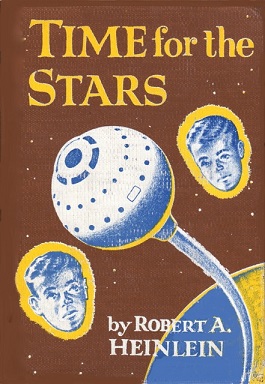Time for the Stars

First Edition cover
|
|
| Author | Robert A. Heinlein |
|---|---|
| Cover artist | Clifford Geary |
| Country | United States |
| Language | English |
| Series | Heinlein juveniles |
| Genre | Science fiction novel |
| Publisher | Scribner's |
|
Publication date
|
1956 |
| Media type | Print (hardback & paperback) |
| Preceded by | Tunnel in the Sky |
| Followed by | Citizen of the Galaxy |
Time for the Stars is a science fiction novel by Robert A. Heinlein published by Scribner's in 1956 as one of the Heinlein juveniles. The basic plot line is derived from a 1911 thought experiment in special relativity, commonly called the twin paradox, proposed by French physicist Paul Langevin.
The Long Range Foundation (LRF) is a non-profit organization that funds expensive, long-term projects for the benefit of mankind. It has built a dozen exploratory torchships to search for habitable planets to colonize. The vessels can continually accelerate, but cannot exceed the speed of light, so the voyages will last many years. Each starship has a much larger crew than necessary to maintain a more stable, long-term shipboard society, as well as provide replacements for the inevitable deaths.
It is found that some twins and triplets can communicate with each other telepathically. The process seems to be instantaneous and unaffected by distance, making it the only practical means of communication for ships traveling many light years away from Earth. Before announcing the discovery, the foundation first recruits as many of these people as it can. Testing shows that teenagers Tom and Pat Bartlett have this talent and both sign up. Pat, the dominant twin, manipulates things so that he gets selected as the crew member, much to Tom's annoyance. However, Pat does not really want to leave and his subconscious engineers a convenient accident so that Tom has to take his place at the last minute.
On board, Tom is pleased to find that his uncle Steve, a military man, has arranged to get assigned to the same ship. The trip is fraught with problems as trivial as an annoying roommate and as serious as mutiny. The ship visits several star systems. Due to the nature of relativistic travel (see twin paradox), the twin who remained behind ages faster and eventually the affinity between them is weakened to the point that they can no longer communicate easily. Some of the spacefaring twins, including the protagonist, are able to connect with descendants of the Earthbound twins. Tom works with first his niece, then his grandniece and finally his great-grandniece.
...
Wikipedia
